Filigree elevates your metal jewelry design by transforming simple pieces into intricate, lace-like artworks that maximize visual impact while minimizing material costs. You’ll create stunning openwork patterns that enhance light play and depth, making smaller gemstones appear larger and more brilliant. The delicate wirework adds perceived luxury and craftsmanship value that distinguishes your pieces from mass-produced jewelry. This ancient technique lets you blend traditional artistry with modern precision, creating unique designs that capture both geometric elegance and organic beauty for truly exceptional results.
What Is Filigree and Why Does It Matter in Jewelry Design
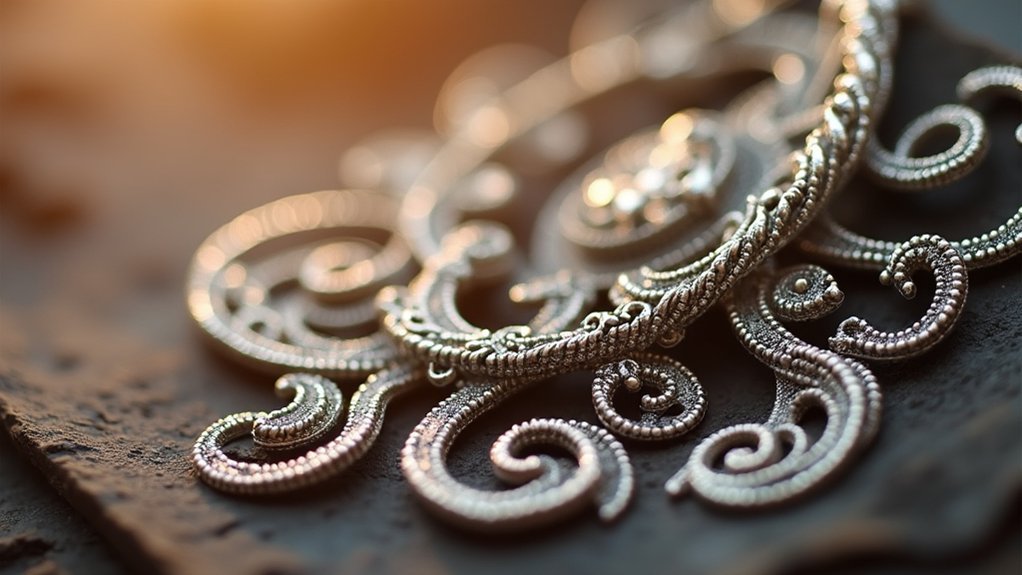
Mastery of metalwork reaches its pinnacle in filigree, a decorative jewelry technique that transforms fine gold or silver threads into intricate, lace-like patterns through careful twisting and weaving.
You’re witnessing an art form that’s survived over 5,000 years, from ancient Mesopotamia to modern workshops.
This technique matters because it delivers extraordinary visual impact while using minimal material. You’ll create lightweight pieces that don’t compromise on elegance or sophistication.
The intricate designs demand exceptional craftsmanship, ensuring each piece carries unique artistic value that sets your work apart.
When you master filigree, you’re combining historical tradition with contemporary jewelry design possibilities.
You’ll appeal to clients who appreciate both timeless artistry and modern aesthetics, positioning your creations as premium pieces in today’s competitive market.
The Ancient Origins and Cultural Heritage of Filigree
When you trace filigree’s origins back to 3,000 BCE, you’re exploring archaeological treasures from ancient Mesopotamia and Greece that reveal humanity’s earliest attempts at this delicate metalwork.
Archaeological discoveries from ancient Mesopotamia and Greece unveil humanity’s first delicate filigree metalwork dating back 5,000 years.
This ancient technique flourished throughout the Roman Empire, where craftsmen created elaborate decorative jewelry that spread across vast territories.
You’ll discover how different civilizations developed their own interpretations of filigree.
Egyptian, Greek, and Etruscan artisans each contributed unique elements to this cultural heritage, creating distinctive regional styles that reflected their artistic values.
The Victorian era brought filigree back into fashion, featuring romantic motifs like hearts and flowers.
These intricate designs demonstrate how filigree transcends cultural boundaries, maintaining its relevance across millennia while adapting to contemporary aesthetic preferences in jewelry traditions worldwide.
Understanding the Traditional Filigree Manufacturing Process
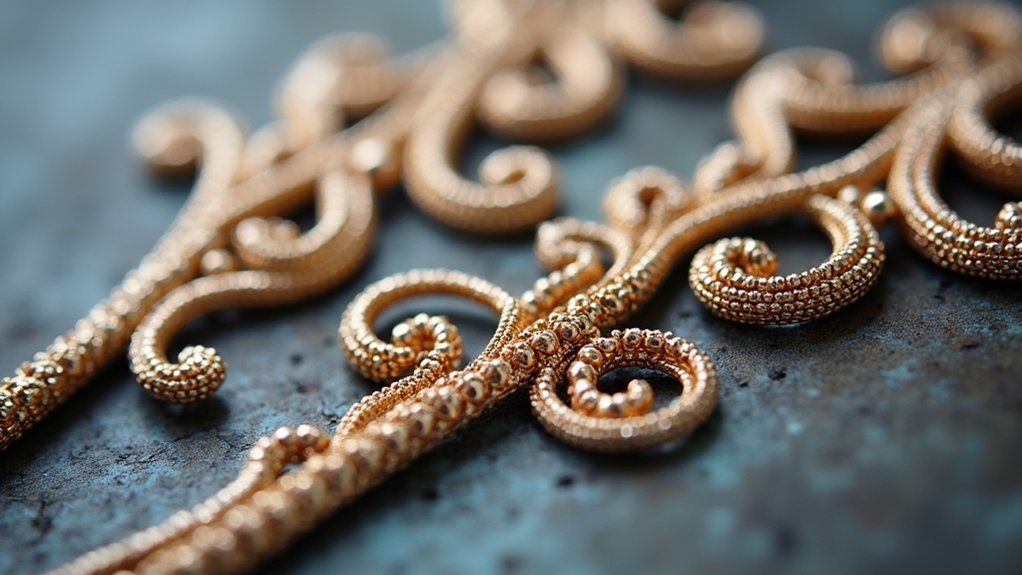
Creating filigree jewelry demands extraordinary skill as you begin by drawing precious metals into incredibly fine, threadlike strips through a painstaking process that separates master craftsmen from novices.
You’ll twist and arrange these delicate strands into intricate patterns, often drawing inspiration from nature or geometric designs that showcase the filigree technique’s artistic potential.
Next, you’ll solder the arranged threads onto a metal base, requiring meticulous attention to enhance both design and structural integrity.
Traditional jewelry making relies on hand tools and magnifying loupes to achieve the fine details that define authentic filigree work.
Modern CAD technology and laser cutting now offer greater precision while preserving the artistry that makes filigree exceptional in contemporary jewelry design.
Modern Technology’s Impact on Filigree Creation
Although traditional filigree techniques have remained largely unchanged for centuries, today’s digital revolution transforms how you’ll approach this ancient craft.
Modern technology like CAD software lets you create precise filigree designs with enhanced accuracy and detail that surpasses hand-drawn patterns. You’ll find laser cutting technology revolutionizes production by delivering intricate designs quickly and consistently while reducing labor costs.
CAD software delivers unmatched precision in filigree design while laser cutting revolutionizes production with speed and consistency.
3D printing enables you to prototype pieces, visualizing and refining your creations before traditional manufacturing. Advanced welding techniques, including oxygen-acetylene welding, provide stronger joints while preserving delicate appearances.
You can now explore hypoallergenic metals like platinum and innovative alloys, expanding your design possibilities. This intricacy was previously unachievable, allowing more varied designs without compromising structural integrity.
How Filigree Enhances Visual Appeal and Perceived Value
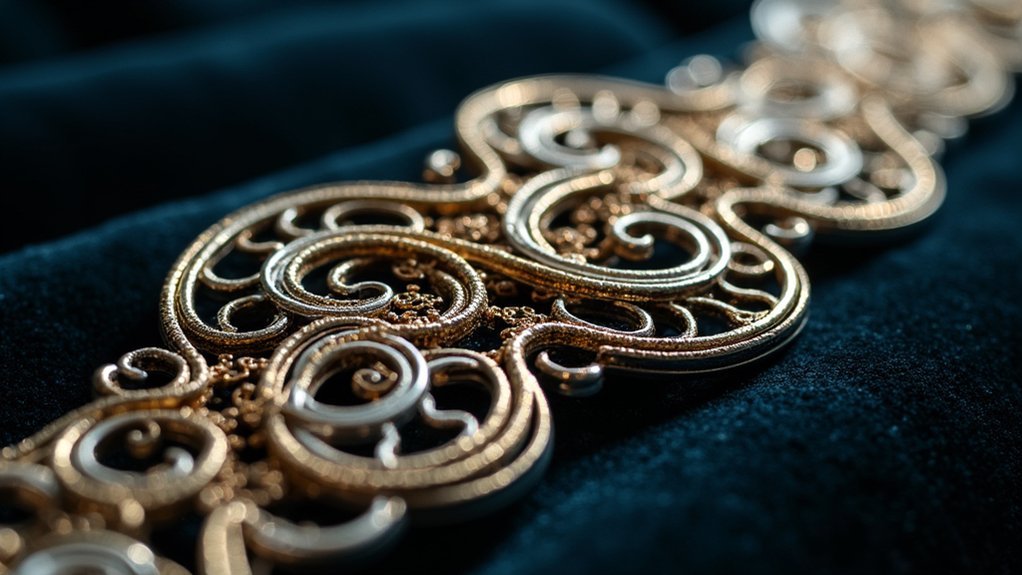
Filigree’s delicate metalwork transforms ordinary jewelry into enchanting art pieces that command attention and admiration.
When you incorporate filigree work into your jewelry designs, you’re creating intricate lace-like patterns that add remarkable depth and visual interest. The delicate threads of metal work strategically to make smaller diamonds and gemstones appear larger and more valuable than they actually are.
Your filigree pieces instantly evoke romantic, vintage aesthetics that collectors and jewelry enthusiasts crave:
- Enhanced perceived value through superior craftsmanship demonstration
- Cost-effective elegance using less material while maintaining sophistication
- Broader market appeal with affordable statement pieces
The skilled artistry required for creating delicate threads of metal signals premium quality to consumers.
You’ll find that filigree work allows you to craft larger, more impressive pieces without excessive material costs, making luxury accessible while maintaining exclusivity.
Cost-Effective Design Solutions Through Filigree Techniques
When budget constraints challenge your jewelry design ambitions, filigree techniques offer an elegant solution that maximizes impact while minimizing costs. You’ll discover that openwork patterns require considerably less precious metals than solid designs, dramatically reducing material expenses while maintaining sophisticated aesthetics.
| Design Approach | Material Usage | Production Cost | Visual Impact | Market Appeal |
|---|---|---|---|---|
| Solid Metal | High | Expensive | Heavy/Bold | Limited Budget |
| Basic Filigree | Medium | Moderate | Elegant/Detailed | Mid-Range |
| Intricate Filigree | Low | Cost-Effective | Luxurious/Delicate | Wide Market |
| Laser-Cut Filigree | Minimal | Most Efficient | Precise/Modern | Broad Appeal |
| Traditional Hand | Variable | Labor-Intensive | Artisanal/Unique | Premium Niche |
Modern laser cutting technology makes creating precise filigree pieces more efficient than traditional handcrafting. You’ll enhance smaller gemstones’ visual prominence, making them appear more significant without purchasing larger stones. This cost-effective approach delivers exceptional value to your customers.
Choosing the Right Metals for Durable Filigree Work
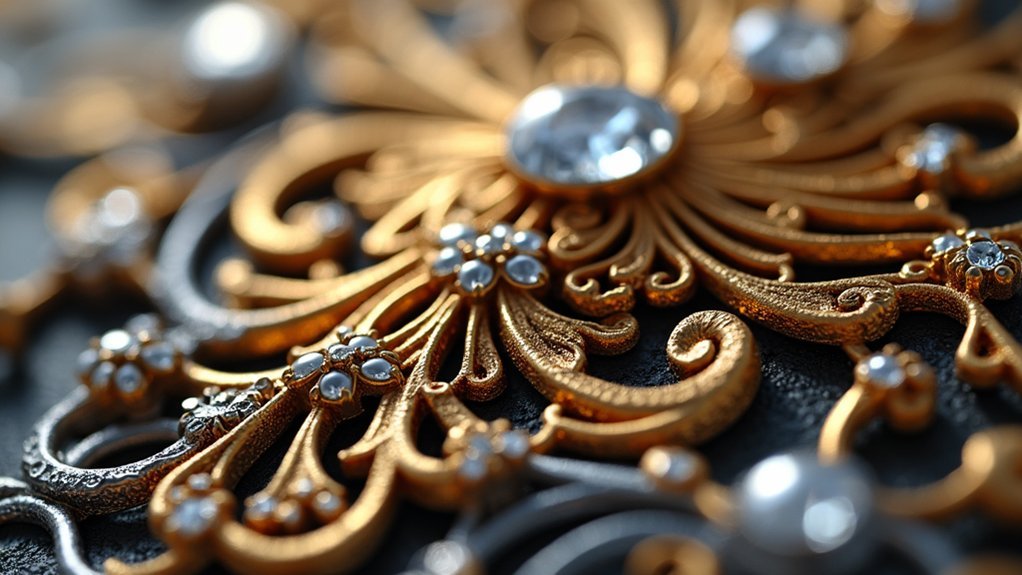
When you’re designing filigree jewelry, your metal choice directly affects how well your intricate work will endure daily wear and environmental factors.
You’ll need to weigh platinum’s exceptional durability against gold’s varying strength levels based on karat content, while considering whether silver’s traditional appeal outweighs its maintenance requirements.
Your decision impacts not only the piece’s longevity but also its weight, comfort, and overall performance in complex designs.
Platinum’s Superior Durability
The endurance of your filigree masterpiece depends heavily on your metal selection, and platinum stands as the ultimate choice for longevity. Unlike softer metals, platinum’s exceptional durability resists scratches and damage that could compromise your intricate designs.
You’ll find that platinum maintains its structural integrity even in the most delicate filigree work.
Platinum’s superior properties make it ideal for lasting beauty:
- Tarnish-resistant – Your pieces retain their luster without corrosion
- Hypoallergenic – Perfect for sensitive skin while preserving design integrity
- Dense composition – Enables complex detailing without sacrificing strength
When you’re creating heirloom-quality filigree, platinum guarantees your intricate patterns remain pristine for generations. Its density allows for exceptional detail work while providing the durability necessary for pieces meant to last.
Gold Karat Considerations
Gold’s karat rating directly impacts your filigree’s longevity and workability. When you’re crafting intricate designs, you’ll find that 14k gold offers superior durability compared to higher karat options. While 24k gold might seem luxurious, it’s too soft for delicate filigree work and prone to breakage.
| Gold Karat | Durability | Best For |
|---|---|---|
| 10k | Excellent | Heavy-wear pieces |
| 14k | Very Good | Intricate designs |
| 18k | Good | Moderate detail |
| 22k | Fair | Simple patterns |
| 24k | Poor | Display only |
Lower gold karat content contains more alloy metals, strengthening your filigree against everyday wear. You’ll achieve better tensile strength and resistance to bending, ensuring your masterpiece maintains its beauty over time while still offering the workability needed for complex patterns.
Silver Versus Alternatives
Although silver remains the traditional cornerstone of filigree craftsmanship, you’ll discover that modern alternatives can dramatically enhance your jewelry’s longevity and performance.
While silver filigree offers exceptional malleability for intricate designs, it requires ongoing maintenance due to tarnishing. Consider these superior alternatives:
- Platinum – Provides hypoallergenic properties, superior durability, and requires zero tarnish maintenance
- Gold (lower karat) – Delivers excellent workability while maintaining luxurious appeal and structural integrity
- Modern alloys – White gold and rose gold expand aesthetic possibilities without sacrificing quality
When choosing metals, prioritize weight considerations—lighter options enable larger designs without compromising comfort.
Gold balances workability with durability perfectly, while platinum offers unmatched longevity. These alternatives guarantee your filigree pieces maintain their beauty for generations.
Filigree’s Role in Victorian and Edwardian Jewelry Revival
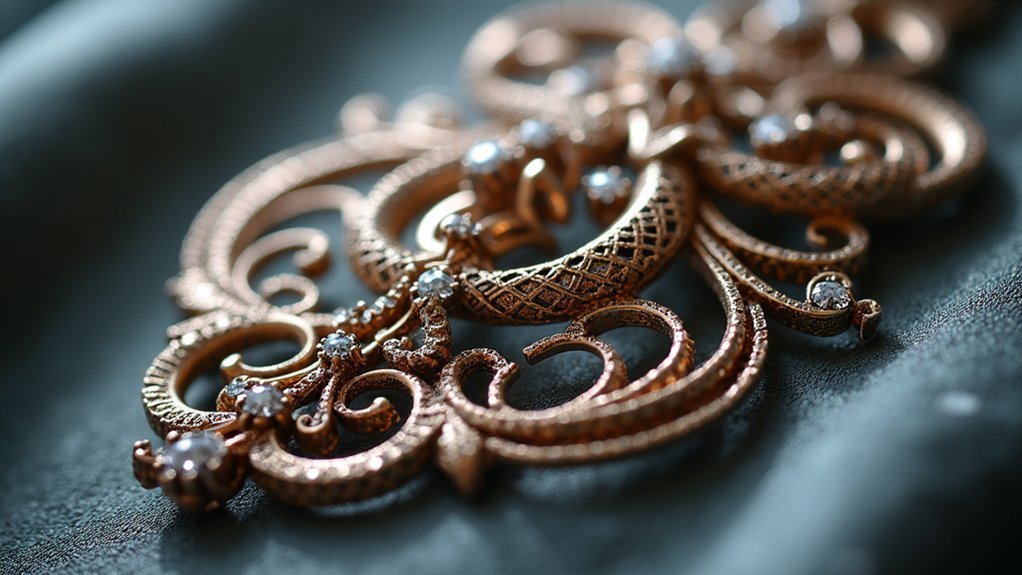
You’ll discover that filigree experienced its most romantic transformation during the Victorian era, when artisans embraced sentimental motifs like hearts, flowers, and birds that captured the period’s emotional spirit.
The Edwardian period elevated this craft to new heights through platinum filigree mastery, incorporating the luxurious Garland Style with diamond accents that defined sophisticated elegance.
Today’s designers draw inspiration from these historical revivals, creating modern vintage-inspired adaptations that honor traditional techniques while meeting contemporary tastes.
Victorian Sentimental Motif Renaissance
Romance breathed new life into filigree during the Victorian era, as jewelers transformed this ancient technique into vehicles for heartfelt expression.
You’ll find that Victorian artisans revolutionized the jewelry industry by infusing delicate designs with profound emotional significance between 1837 and 1901.
The sentimental motifs that defined this renaissance included:
- Hearts symbolizing eternal love and devotion
- Flowers representing beauty, growth, and remembrance
- Birds conveying freedom, hope, and spiritual connection
These intricate symbols weren’t merely decorative—they served as coded messages between lovers and family members.
When you examine Victorian filigree pieces today, you’re witnessing a masterful blend of technical skill and emotional storytelling.
The lace-like metalwork created lightweight yet visually striking jewelry that allowed wearers to express their deepest feelings through carefully chosen motifs.
Edwardian Platinum Filigree Mastery
Platinum’s emergence as the metal of choice revolutionized filigree craftsmanship during the Edwardian period from 1901 to 1910.
You’ll discover how this strong metal enabled artisans to create the era’s signature “Garland Style” with unprecedented delicacy. The intricate art form flourished as platinum’s durability supported elaborate lace-like patterns and floral motifs that would’ve been impossible with softer metals.
When you examine Edwardian jewelry, you’ll notice how openwork designs allow light to dance through each piece, creating stunning visual depth.
The addition of milgrain detailing enhanced texture and elevated the artistic value of these masterpieces. This refined approach marked a deliberate shift from Victorian opulence toward sophisticated elegance, establishing filigree as the defining characteristic of early twentieth-century luxury jewelry.
Modern Vintage-Inspired Adaptations
Today’s jewelry designers have embraced the romantic allure of bygone eras, breathing new life into the filigree mastery that defined Victorian and Edwardian craftsmanship.
You’ll find that modern vintage-inspired pieces capture the same intricate techniques that made Victorian sentimental motifs and Edwardian Garland Style so enchanting.
Contemporary filigree jewelry reflects three key revival elements:
- Nostalgic craftsmanship that consumers actively seek for its historical authenticity
- Romantic design aesthetics featuring hearts, flowers, and elaborate detailing
- Timeless heirloom quality that stands out in modern collections
The delicate nature of filigree work continues to enhance these vintage-inspired adaptations, allowing you to create pieces that bridge centuries of artistry.
This resurgence proves that traditional metalworking techniques remain relevant in today’s jewelry market.
Art Deco Influences on Contemporary Filigree Designs
While the Art Nouveau period celebrated organic curves and nature-inspired motifs, the Art Deco movement that followed in the 1920s and 1930s brought a revolutionary change to filigree jewelry design.
The Art Deco period emphasized bold geometric shapes and streamlined aesthetics that transformed contemporary filigree into something entirely different. You’ll notice how intricate patterns now feature clean lines and symmetrical forms, creating striking contrasts to previous ornate styles.
Art Deco’s geometric precision revolutionized filigree design, replacing flowing organic motifs with bold symmetrical patterns and clean architectural lines.
This era popularized platinum in filigree work, and you’ll appreciate how its durability and luster enhance detailed craftsmanship.
Today’s designers combine traditional filigree techniques with colored gemstones, giving you modern twists on classic elegance. These revived Art Deco styles celebrate both historical artistry and contemporary sensibilities, appealing to diverse jewelry enthusiasts.
Nature-Inspired Motifs and Geometric Patterns in Filigree
Beyond the geometric precision that defines Art Deco filigree, contemporary artisans draw inspiration from two distinct yet complementary design philosophies: the organic curves of nature and the structured beauty of geometric forms.
You’ll find that nature-inspired motifs like leaves, flowers, and vines bring organic beauty to your designs, while geometric patterns showcase sharp lines and symmetrical elegance.
The intertwining filigree threads create intricate lace-like effects that perfectly balance both aesthetics.
This dual approach offers several advantages:
- Combines fluid natural elements with structured geometric forms
- Creates visual depth and complexity in jewelry pieces
- Appeals to diverse artistic preferences and style sensibilities
You’ll discover that this delicate balance transforms each filigree piece into a visual feast, blending technical precision with organic inspiration.
Maintenance Requirements for Delicate Filigree Pieces
Since filigree’s intricate wirework creates stunning visual effects, it also demands meticulous care to preserve its delicate beauty.
The delicate artistry of filigree wirework requires gentle handling and thoughtful preservation to maintain its intricate splendor.
You’ll need to handle these pieces gently, avoiding harsh chemicals that can compromise the fine metalwork. When cleaning your filigree jewelry, use a soft brush with mild soap to prevent scratching the detailed patterns.
Store your pieces in padded jewelry boxes to prevent tangling and damage to the delicate threads. If your filigree features soft stones, you should seek professional cleaning to maintain their integrity.
This careful maintenance approach becomes especially important with antique jewelry, where the filigree may have become more fragile over time. Proper care guarantees your delicate filigree pieces retain their intricate beauty for years.
Combining Filigree With Gemstones for Maximum Impact
When you combine filigree with gemstones, you’ll create jewelry pieces that showcase both elements at their finest. The intricate metalwork acts as a stunning backdrop that enhances your stones’ natural beauty while making smaller gems appear more prominent and striking.
You’ll find that filigree’s delicate patterns highlight gemstone colors and brilliance through creative contrasts. The lace-like designs can be tailored to complement your stone’s specific shape and cut, ensuring visual harmony throughout your piece.
Consider these design advantages when incorporating gemstones into filigree jewelry:
- Enhanced visual appeal makes smaller stones appear larger and more impactful
- Versatile settings accommodate everything from classic diamonds to vibrant colored stones
- Customizable patterns accentuate each gemstone’s unique characteristics
This combination allows you to blend traditional craftsmanship with contemporary trends.
Creating Unique Design Elements Through Openwork Patterns
You can transform your metal jewelry designs by incorporating lace-like patterns that mimic the intricate beauty of traditional textile work.
Nature-inspired geometric motifs allow you to create pieces that blend organic flowing lines with structured mathematical precision.
These openwork techniques give you the freedom to develop signature design elements that set your jewelry apart from mass-produced alternatives.
Lace-Like Metal Patterns
Few techniques in jewelry making can match the ethereal beauty that filigree brings to metal design. When you create lace-like metal patterns, you’re practicing an ancient art that transforms ordinary metal into extraordinary masterpieces.
These designs using fine threads create delicate openwork that mimics the intricate beauty of handmade lace.
Your filigree patterns offer remarkable versatility through various aesthetic approaches:
- Romantic motifs featuring flowing curves and floral elements
- Bold geometric patterns with precise angular formations
- Nature-inspired designs incorporating organic shapes and textures
Whether you’re crafting contemporary pieces or drawing inspiration from antique filigree jewelry, you’ll find that these lace-like patterns add sophistication and visual interest.
The interplay between solid metal and open spaces creates depth, allowing light to dance through your designs while showcasing your technical mastery and artistic vision.
Nature-Inspired Geometric Motifs
While geometric patterns might seem rigid at first glance, nature-inspired geometric motifs in filigree transform mathematical precision into organic poetry.
You’ll discover that filigree designs masterfully blend structured shapes with flowing natural elements like leaves, flowers, and vines. This intricate craftsmanship creates openwork patterns that capture light and shadow, bringing your geometric forms to life.
When you incorporate nature-inspired motifs into geometric frameworks, you’re achieving perfect balance between order and organic beauty. The delicate metal threads mimic nature’s textures while maintaining structural integrity.
You can experiment with varying degrees of openness, personalizing your creative expression. This versatile approach lets you craft unique jewelry pieces that showcase both mathematical precision and natural elegance, elevating your designs beyond simple geometric repetition.
The Future of Filigree in Modern Jewelry Collections
As consumer preferences shift toward artisanal craftsmanship and meaningful design, filigree is experiencing a remarkable renaissance in modern jewelry collections.
You’ll find contemporary artisans pushing boundaries by combining traditional techniques with innovative materials like alternative metals and unique gemstones, creating pieces that tell your personal story through intricate designs.
Technology’s revolutionizing how you can access filigree jewelry:
- CAD and laser cutting enable precise designs at lower costs
- Expanded production makes filigree accessible to wider audiences
- Efficient manufacturing drives market growth while maintaining quality
You’re no longer limited to rings—filigree now appears in earrings, necklaces, and beyond, offering versatile options for every style.
This ancient craft’s ability to reflect individuality through detailed craftsmanship guarantees its continued relevance in tomorrow’s personalized jewelry landscape.
Frequently Asked Questions
What Is the Significance of Filigree?
Filigree’s significance lies in its ancient artistic heritage and unique lace-like aesthetic. You’ll appreciate how this technique transforms simple metal threads into intricate designs, offering cost-effective elegance that’s captivated civilizations for millennia.
What Does the Filigree Symbol Mean?
You’ll find filigree symbols represent elegance, eternal love, and connection to nature through intricate lace-like patterns. They embody craftsmanship, cultural heritage, and harmony, making your jewelry pieces meaningful reflections of artistry and sophistication.
What Is the Difference Between Engraving and Filigree?
You’ll find engraving carves designs directly into metal surfaces, creating solid, textured effects. Filigree uses delicate metal threads forming lace-like patterns with open spaces, giving your jewelry a lighter, more dimensional appearance.
What Is Metal Filigree?
You’ll find metal filigree is a delicate decorative technique where you twist and weave fine metal threads into intricate, lace-like patterns. It’s an ancient art form that creates stunning, detailed jewelry designs.
In Summary
You’ll discover that filigree isn’t just decorative—it’s transformative. By incorporating this ancient technique, you’re adding layers of sophistication and cultural richness to your designs. Whether you’re using traditional handcrafting methods or modern technology, filigree creates that coveted delicate appearance customers crave. Don’t overlook its potential to elevate simple metal pieces into heirloom-quality jewelry that commands premium pricing and lasting admiration.

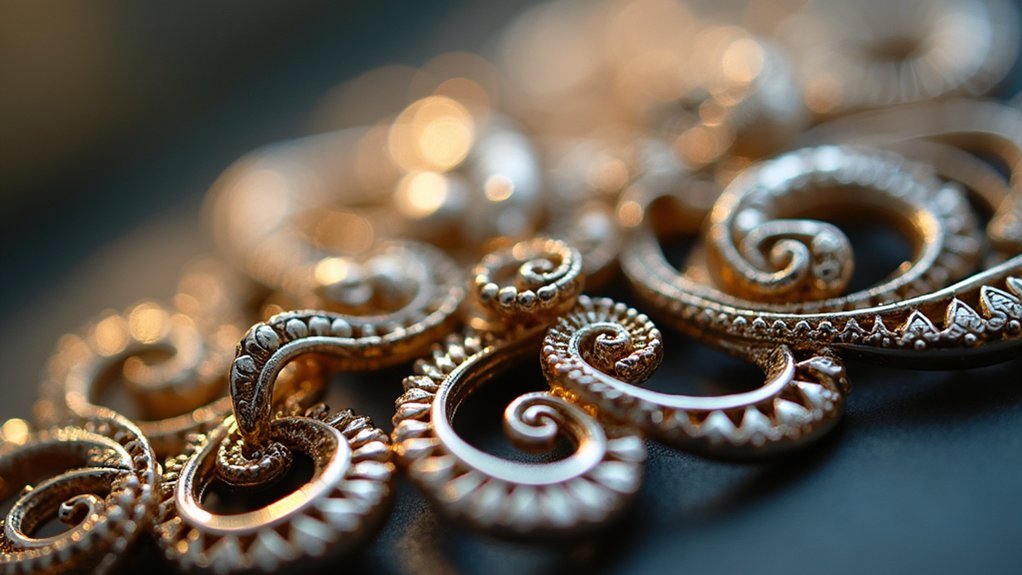
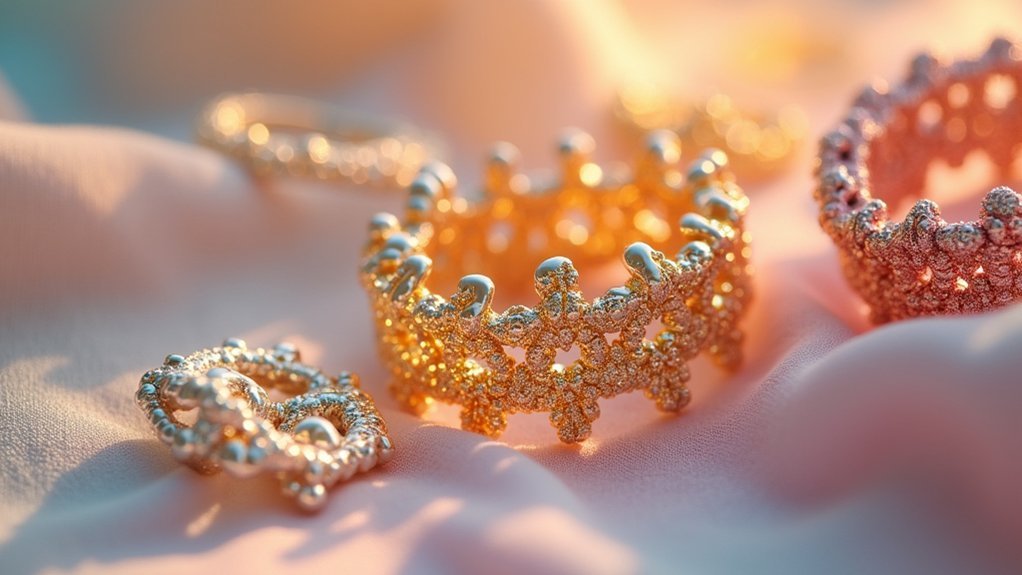
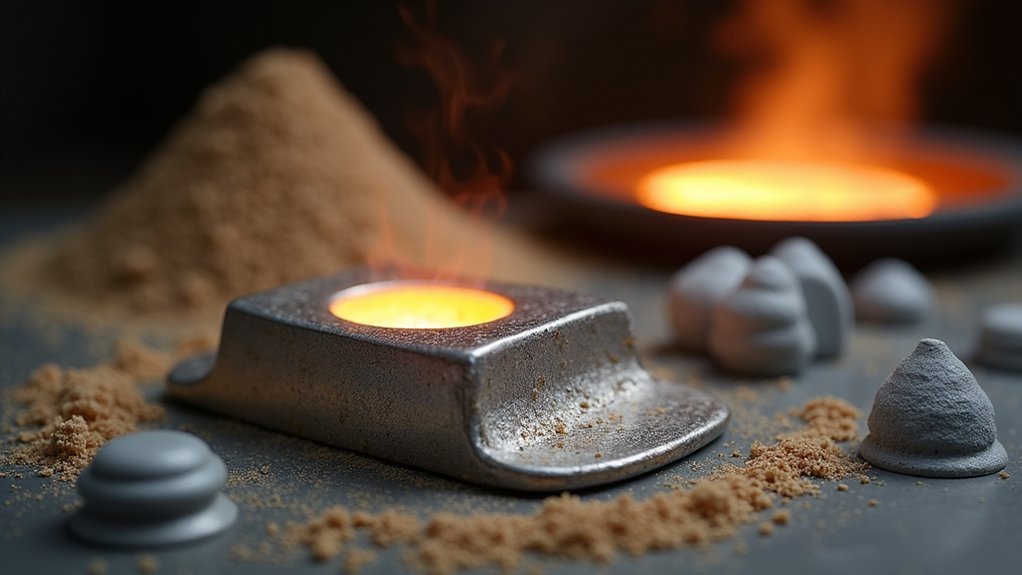

Leave a Reply